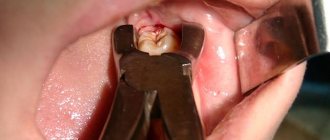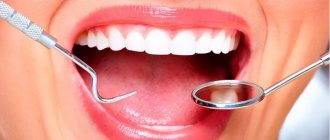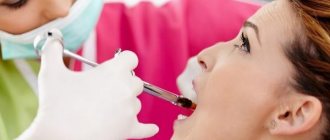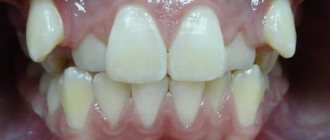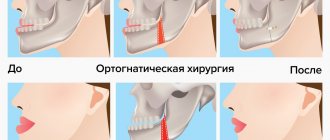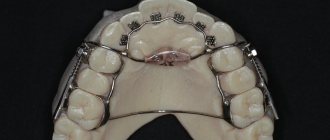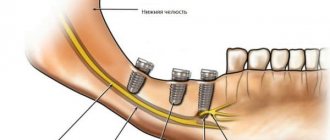- Osteoplastic surgeries of the maxillofacial area
- Mandibular osteotomy
- Maxillary osteotomy
- Genioplasty - chin plastic surgery
- Genioplasty for chin asymmetry
- Sectoral osteotomy of the anterior maxilla
- Sectoral osteotomy of the lateral maxilla
| |
Indications
The operation is performed to correct the bite and deformities of the lower jaw. For diagnoses: prognathism and retrognathia of the lower jaw.
This type of surgery is performed together with an orthodontist. Orthodontic treatment is carried out both at the preoperative stage of bite preparation and after surgery.
Features of lower wisdom tooth removal
“Eights” on the lower jaw appear by the age of 20-25, when the main row of teeth is already formed and fully performs its functions. Therefore, the process of “growing” extreme molars is often not very pleasant and is accompanied by various difficulties, ranging from slight discomfort to serious destructive processes in the jaw. In this case, dentists are guided by the principle “seven troubles - one answer”: no matter what problems a wisdom tooth brings, there is only one way to get rid of them - removal.
Indications for surgery
So when is it necessary to remove a wisdom tooth in the lower jaw? In most cases, indications for surgery are related to certain pathologies of the lower “eight”.
- The wisdom tooth erupted incorrectly
- that is, not straight up, but with a deviation, at an angle to the jaw and neighboring teeth. The slope of the figure eight is:
- distal
- when the “eight” is tilted back, away from the “seven”. In this case, there is a risk of injury to the gums and damage to the roots of the adjacent tooth; - medial
- when the “eight”, on the contrary, is inclined towards the adjacent tooth. This increases the likelihood of damage to the crown part of the “seven” and the development of caries on both teeth; - buccal
- in this case, the wisdom tooth is turned towards the cheek and constantly touches the mucous membrane, causing irritation and hardening of the tissues. This condition can eventually lead to the formation - tumors on the mucosa.
- lingual
- when the tooth is tilted inward, it touches the tongue and damages it, making it difficult to eat and communicate.
- The wisdom tooth has erupted partially or not at all
- dentists call this condition partial or complete retention.
- With complete retention,
the molar does not come to the surface, remaining under the gum, inside the jaw. An impacted tooth may not show itself in any way - in this case, only regular treatment is indicated for control. However, in some cases, a “hidden” molar can cause a lot of problems for the patient, especially if it is located horizontally rather than vertically in the jaw. A lying tooth can damage blood vessels, destroy the jaw bone, provoke inflammation and suppuration under the gum, be very painful, lead to a shift in the dentition, and even cause the appearance of a cancerous tumor. In this case, the patient must have the lower “eight” removed. - With incomplete retention,
the tooth comes to the surface only partially, and this also poses a danger to the patient. A semi-retinated tooth injures the gums, damages the enamel of the neighboring tooth, makes it difficult to access the “seven” for hygiene procedures, and provokes the development of caries. Removing it solves all these problems.
- A wisdom tooth interferes with the normal functioning of the maxillofacial apparatus.
Even if the “eight” erupts smoothly, does not cause inflammation and does not injure soft tissues, over time it can still complicate the patient’s life.
- The appearance of caries.
Due to the difficulty of access, it is not always possible to properly clean the distal molar with a toothbrush. The accumulation of bacteria and food debris leads to caries, which can spread to neighboring teeth. In this case, removal of the lower wisdom tooth is a prerequisite for maintaining the health of the entire oral cavity. - Crowding and displacement of teeth.
Occurs if the volume of the jaw is small and the new molar becomes cramped in the dentition. In this case, the “figure eight” can provoke a shift in the dentition, twisting of the teeth, and malocclusion. After removal everything returns to normal.
Symptoms
Exostosis of the tooth appears in the form of a convex growth that appears for no apparent reason. Main symptoms:
- Sensation of a foreign body in the mouth;
- discomfort when eating, talking (with large osteophytes);
- pain when pressing on the tumor;
- redness, thinning of the mucous membrane in the pathological area.
A small anomaly can only be detected during a dental examination, since visually it does not manifest itself in any way.
When is it better not to remove a wisdom tooth?
It seems that removing the lower wisdom tooth is the best solution to all problems, but this is not always true. In many patients, the eruption of “eights” occurs without complications, and in the future these teeth do not cause inconvenience, so there is no need for surgery. Also, you should not pull out your lower wisdom tooth if:
- dental prosthetics are planned and the third molar can become a support for a bridge;
- "seven" is missing. In this case, the wisdom tooth will take its place;
- caries affects only the upper part of the wisdom tooth. Then, instead of a traumatic removal operation, you can perform a regular filling, the price of which will be lower.
Relative contraindications to wisdom tooth removal are:
- infectious and inflammatory processes affecting the oral cavity
- for example, periodontal disease. In this case, you first need to stop the inflammation and take a course of antibiotics, and only then proceed to remove the molar; - respiratory diseases
- influenza, ARVI. They can provoke postoperative complications; - pregnancy and breastfeeding;
- cardiovascular diseases
in the acute stage.
Summary
Reconstruction and rehabilitation of patients with defects of the upper jaw are the most difficult in reconstructive maxillofacial surgery, occupying the minds of oncological surgeons working in this area, microsurgeons, plastic surgeons and orthopedic dentists involved in maxillofacial and somatotropic prosthetics.
The fundamental difference between patients who have undergone anatomical reconstruction of the alveolar process of the upper jaw, as well as nasal support with microsurgical grafts and patients who have undergone maxillofacial prosthetics with obturation structures is an increase in the volume of the respiratory space, improved speech, the absence of atresia, frequent acute respiratory viral infections and, fundamentally, in the absence of regular relocation of definitive orthopedic work [1]. An important difference is also the lack of mobility of dentures on dental implants, which avoids chronic trauma to surrounding tissues.
This article describes the experience of rehabilitation of patients with defects of the upper jaw using fibular and Chinese skin-bone flaps with further plastic surgery of bone and soft tissues in order to create conditions for dental implantation, orthopedic conditions and features of fixed prosthetics for this group of patients.
The developed protocols for the use of a particular graft on a vascular pedicle are described in terms of the type of defect and further restoration of bone joints, as well as measures for the formation of anatomically close to normal conditions for implantation and prosthetic dentistry in patients with a reconstructed upper jaw.
Differences between figure eight removal on the lower and upper jaws
Removing a third molar in the lower jaw is considered a more complex procedure than removing a wisdom tooth in the upper jaw for a number of reasons.
- Access to the lower molars is more difficult than to the upper ones.
- The lower jaw bone is more massive and dense, it holds the tooth more firmly.
- The pressure on the teeth of the lower jaw is greater than on the upper teeth, so the roots of the lower molars are more developed. In addition, due to improper growth, they can be curved or misaligned.
- It is easier to perform local anesthesia from above, and anesthesia from the bottom often involves the muscles of the face, tongue, throat and ears.
All this makes the procedure for removing the 8th tooth from below a difficult task. If the upper molars in most cases can be easily rocked and pulled out with special forceps, then the lower molars often have to be removed in parts, cutting with a drill.
Aspiration
Another complication that can arise during tooth extraction is aspiration. Aspiration is the penetration of foreign bodies into the airways during inspiration. During tooth extraction surgery, there are cases of aspiration of the tooth, parts of the tooth, needles, cotton swabs, and burs.
The occurrence of aspiration is facilitated by a decrease in the gag reflex after anesthesia and the position of the patient in a chair or operating table with the head thrown back. The foreign body may be located above the vocal cords, in the larynx, trachea and bronchi.
Aspiration Clinic
Clinical signs of aspiration: sudden barking cough, severe shortness of breath, cyanosis of the skin, lips and oral mucosa, motor restlessness and “disappearance” of the extracted tooth, part or instrument.
Urgent Care. The patient is transferred to a sitting position with the torso tilted forward and down, and he is asked to “clear his throat.” In between coughing attacks, the oropharynx is examined and palpated, pulling the tongue forward. If a foreign body is detected in the oropharynx, it is removed with tweezers or a finger.
If a foreign body is not found in the oropharynx, and signs of asphyxia (suffocation) increase, one can think about the presence of a foreign body in the hypopharynx or larynx. In such a situation, one of the staff of the medical institution calls the resuscitation team by phone and prepares everything necessary for tracheotomy. Meanwhile, the doctor, having seated the patient on a stool and standing behind him, clasps his chest with his hands. Then he sharply compresses the chest, lifting the patient, thereby forcing exhalation. He repeats this artificial respiration technique several times. If these resuscitation measures do not help, asphyxia increases, and a tracheotomy is performed.
Prevention of aspiration
Prevention of aspiration consists of the following measures: careful use of small instruments, checking the fixation of the needle on the syringe, careful removal technique. If any tooth fragments disappear, it is necessary to examine the oral cavity and, if a foreign body is found, remove it. If small instruments, teeth, or their fragments get into the oral cavity, the patient should be asked to lean forward and spit the contents of the oral cavity into the spittoon, rinse the mouth with water and spit again.
Easy removal
If the wisdom tooth has erupted correctly, grows evenly and has straight, untwisted roots, then there is every chance of getting by with a simple operation, which is carried out in 4 stages.
- Diagnostics
, including examination and x-ray, allows the doctor to get a more accurate idea of the upcoming operation. - Anesthesia.
Generally, local anesthesia is used for simple wisdom teeth removal. - Tooth extraction.
The doctor applies forceps, gently rocks the tooth and removes it using a special tool - an elevator. If fragments of roots remain in the hole, they are also carefully removed. - Treatment of the hole and suturing of the gums.
Antiseptic and anti-inflammatory solutions are used. In some cases, stitches are placed to protect the wound from bacteria, and the patient is sent back for rehabilitation. As reviews show, in the case of simple removal it takes very little time.
Best results with 3D planning
The V-Line operation is designed to create a feminine and aristocratic oval face, an elegant small chin, and a more youthful appearance by changing the jaw line.
The VIP Studio virtual plastic laboratory makes it possible to 3D model the ideal proportions and desired shapes before surgery. Based on computed tomography and light scanning data, an accurate three-dimensional model of the face, head and neck is formed. The surgeon and the patient jointly plan the scope of the intervention; based on the model, calculations are made that are used during the operation.
Thanks to the VIP Studio virtual plastic technology, which Dr. Guryanov uses in his work, the result of the operation is as close as possible to the client’s expectations.
Complex removal of the lower wisdom tooth
Impacted, semi-impacted, horizontal teeth, as well as teeth with curved, twisted, branched roots, are much more difficult to remove. Preparation for such an operation is similar to uncomplicated cases (although general anesthesia is sometimes used), but the extraction of the tooth itself requires additional effort from the doctor. Almost always you have to resort to cutting the gums, and the tooth is cut with a drill and removed in parts. Then the gum is sutured. In general, the volume of intervention during complex removal of an impacted wisdom tooth is always greater than during simple removal.
Is it painful to remove a lower wisdom tooth?
The question worries everyone who is planning to get rid of the “eights,” especially if the case is complex. Patients’ concerns are understandable: after all, wisdom tooth removal is a full-fledged operation. However, there is no need to be afraid of pain. During the process of cutting the gums, sawing and extracting the molar, the patient may feel pressure, vibration or stretching, but nothing more: modern anesthetics make the process absolutely painless.
After the anesthesia wears off, pain may become more intense, so the doctor will definitely prescribe painkillers to make the recovery period as comfortable as possible. If healing proceeds without complications, they will have to be taken for 2 to 5 days, depending on the extent of the intervention. As the soft tissues recover, the pain gradually becomes more tolerable and soon disappears completely.
V-Line surgery – to make your face oval!
A massive, wide, heavy jaw looks impressive in men, but does not adorn women. An elongated, angular or square lower part of the face does not correspond to the generally accepted canons of femininity, according to which facial features should be graceful and chiseled.
On the contrary, triangular, oval and intermediate V-shaped face shapes (oval in the form of a “heart”) have been considered a sign of aristocratic origin for centuries. The V-line of the jaw gives a soft, youthful charm to the features, since anatomically the lower third of a child's face is triangular in shape, which is the structure we associate with youth.
Consequences and possible complications
It is necessary to separate the consequences of the operation and complications after it. All patients experience consequences to one degree or another - this is a normal reaction of the body to intervention, but it is better to avoid complications.
Consequences include:
- painful sensations;
- bleeding gums within 3-5 hours after surgery;
- swelling of the gums, cheeks;
- bruises on the face in the area of intervention;
- rise in temperature.
Complications may be as follows:
- prolonged bleeding
- due to the fact that the tissues around the lower “eights” are saturated with blood vessels. In this case, the doctor may apply additional hemostatic measures; - alveolitis
- inflammation of the wound surface associated with infection in the hole. It is characterized by the following symptoms: fever, bad breath, swelling, pain. Requires additional wound treatment and antibiotics; - paresthesia
- loss of facial sensation. Usually the lips, cheeks, and tongue suffer - they do not feel touch, do not distinguish between hot and cold. Loss of sensitivity is associated with damage to the facial nerve and may go away on its own within 1-2 weeks, but in some cases requires additional therapy; - dislocation of the mandibular joint
is a rare but possible complication associated with excessive efforts made by the surgeon to extract the tooth. The dislocation can be corrected immediately.
Attention!!!
Removing a problematic lower molar is a full-fledged operation, so special attention should be paid to the recovery period. It is necessary to strictly follow the doctor’s recommendations and carefully care for the oral cavity, then the likelihood of developing the complications described in the previous section will be minimal. Standard assignments include:
- taking painkillers and antihistamines
- antibacterial rinses
- cold compresses on the cheek in the area of intervention (reduce hematomas and reduce the risk of re-bleeding)
- prohibition on eating during the first hours after surgery
- ban on smoking, drinking alcohol, physical activity
- ban on visiting the sauna and swimming pool, taking hot baths
If the doctor did not make mistakes during the operation, and the patient does not violate the recovery regime, then very soon there will be no trace of unpleasant sensations.

